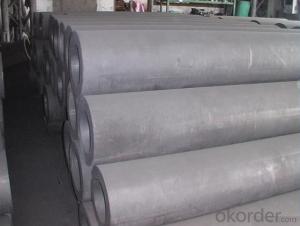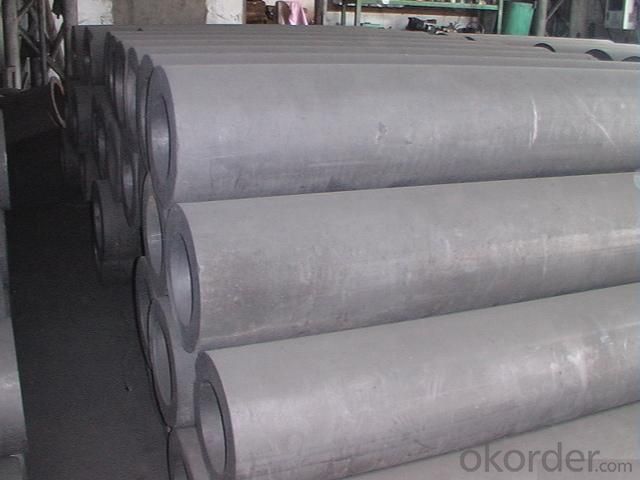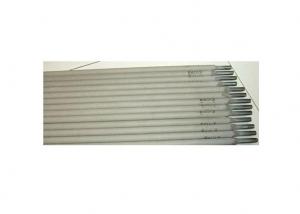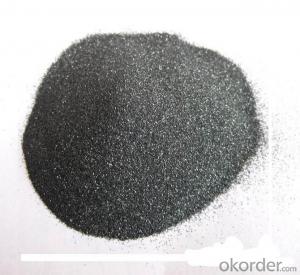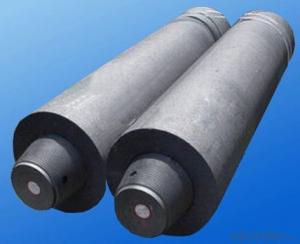Carbon Electrode for Silicon Metal Production
- Loading Port:
- Tianjin
- Payment Terms:
- TT OR LC
- Min Order Qty:
- 20 m.t.
- Supply Capability:
- 800 m.t./month
OKorder Service Pledge
OKorder Financial Service
You Might Also Like
Spcifications
1:carbon eletrode
2:for ferroalloy,calcium carbide, silicon metal, manufacture
Product Description
Carbon Electrode is abaked electrode used in submerged arc furnaces for delivering power to the charge mix. Electrode is added to the top of the electrode column cylindrical form. Electrode is essentially a mix of Electrically Calcined Anthracite (ECA) or Calcined Petroleum Coke (CPC) with Coal Tar Pitch and is baked for weeks, it is widly used for ferroally productiong, silicon metal production etc.
Graphite/Carbon Electrode Paste Specification:
| PARAMETER UNIT GUARANTEE VALUE | ||||||
| Items | Φ500~Φ700 | Φ750~Φ960 | Φ1020~Φ1400 | |||
| Rs μΩ.m | ≤45 | ≤38 | ≤45 | ≤38 | ≤40 | |
| Bulk Desity g/cm3 | ≥1.55 | ≥1.58 | ≥1.55 | ≥1.58 | ≥1.55 | ≥1.58 |
| Bending Strength MPa | 3.5~7.5 | 4.0~7.5 | 3.5~7.5 | 4.0~7.5 | 3.5~7.5 | 4.0~7.5 |
| Compressive Strength MPa | ≥20.0 | ≥20.0 | ≥20.0 | ≥20.0 | ≥19.0 | ≥19.0 |
| Compressive Strength MPa | 3.2~4.8 | 3.0~4.6 | 3.2~4.8 | 3.0~4.6 | 3.2~4.8 | 3.0~4.6 |
| Ash % | ≤2.5 | ≤2.0 | ≤2.5 | ≤2.0 | ≤2.5 | ≤2.0 |
Picture:
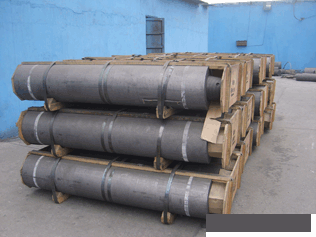
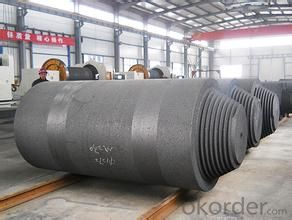
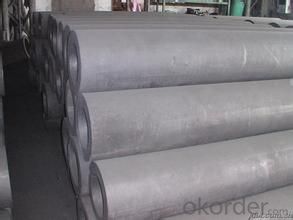
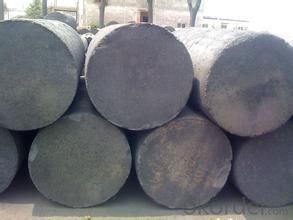
We Also supply all kind of carbon electrode paste and below materials, please contact us if you have any enquiry about it.
Calcined Anthracite
Calcined Petroleum Coke
Coke (Met Coke, Foundry Coke, Semi Coke)
Company information:
China National Building Materials Group is a stated -owned enterprise in charge of administrative affairs in China buiding materials industry.Established in 1984 CNBM is a large group corporation of building materials with total assets of 25 billion and a total stuff of 30000 CNBM now owns 200 subordinating firms of solely owned and joint-venture companies.
- Q: RT~ I remember our teacher said, but I forgot all of a sudden......Ask for advice!
- Well, secondary carbon and oxygen double bonds do not add much. What is involved in high school?:1, in the nickel catalyzed conditions, with H2 addition (also a reduction, but note that in the carboxyl group -COOH carbon oxygen double bond can not be added by the general method plus H)2, aldehyde addition (aldol condensation). The college entrance examination had many times, is simply an aldehyde -CHO under certain conditions and containing active H group reaction R-H (commonly known as alpha H that -H doesn't have to be in the next -CHO H, like -COOH, phenyl can also, but to see more in the next -CHO generation of C- (OH) -R). The H is added to the O, and the alkyl R- is added to the C.For example: CH3-CHO+HCHO==CH3-C (OH) -CHO (called 2- 3-hydroxypropanal)There are some universities, the mechanism involved is more complex, you want to HI me
- Q: How are carbon markets regulated?
- The integrity and transparency of emissions trading in carbon markets are ensured through a combination of international, national, and regional frameworks. The United Nations Framework Convention on Climate Change (UNFCCC) is a key international body responsible for overseeing carbon markets. It established both the Kyoto Protocol and the Paris Agreement. The Kyoto Protocol established an international emissions trading system that allows countries to trade emission allowances through the Clean Development Mechanism (CDM) and Joint Implementation (JI) projects. These projects are approved and monitored by the UNFCCC to ensure that emission reductions are genuine, measurable, and additional to what would have occurred without the projects. The Paris Agreement, which succeeded the Kyoto Protocol, introduced the Sustainable Development Mechanism (SDM), a new market mechanism. The SDM is designed to promote sustainable development and assist countries in achieving their climate goals by enabling emission reductions and removals through projects in developing countries. At the national and regional levels, governments and regulatory bodies play a vital role in carbon market regulation. They establish legal frameworks, set emission reduction targets, and develop domestic emissions trading systems. These systems involve the allocation of emission allowances to companies or sectors, monitoring and reporting of emissions, and the trading of allowances on regulated platforms. To maintain the integrity of carbon markets, stringent regulations are in place to prevent fraud, double-counting, and other forms of market manipulation. Independent verification and accreditation bodies are responsible for auditing emissions data and project methodologies to ensure compliance with established rules and standards. Additionally, market oversight and enforcement bodies are established to monitor and enforce compliance with regulations. These bodies have the authority to investigate and penalize non-compliance, including imposing fines or revoking emission allowances. In summary, the regulation of carbon markets encompasses a complex network of international agreements, national laws, and regulatory bodies. The objective is to establish a strong and transparent market that incentivizes emission reductions and supports the transition to a low-carbon economy.
- Q: How does deforestation contribute to carbon dioxide levels in the atmosphere?
- Deforestation contributes to carbon dioxide levels in the atmosphere primarily through the release of stored carbon in trees and vegetation. When forests are cut down or burned, the carbon stored in their biomass is released as carbon dioxide, a greenhouse gas. Additionally, trees play a crucial role in absorbing carbon dioxide during photosynthesis, so their removal reduces the capacity to remove this greenhouse gas from the atmosphere. Therefore, deforestation not only releases carbon dioxide but also diminishes the natural carbon sinks, leading to an overall increase in carbon dioxide levels in the atmosphere.
- Q: What are the effects of carbon emissions on the stability of mangrove forests?
- Carbon emissions have detrimental effects on the stability of mangrove forests. Increased carbon dioxide in the atmosphere leads to ocean acidification, which negatively impacts mangroves by inhibiting their growth and reducing their ability to survive. Additionally, rising temperatures resulting from carbon emissions contribute to sea level rise, which increases the risk of flooding and erosion in mangrove habitats. This disrupts the delicate balance of the ecosystem and threatens the overall stability and biodiversity of mangrove forests.
- Q: How does carbon dioxide affect fuel efficiency?
- Fuel efficiency in vehicles is primarily influenced by factors such as engine efficiency, weight, aerodynamics, and driving conditions. Carbon dioxide, on the other hand, is a byproduct of burning fossil fuels, commonly used as vehicle fuel. When fossil fuels are burned, carbon dioxide is released into the atmosphere, contributing to the greenhouse effect and climate change. However, it is important to note that the increased concentration of carbon dioxide in the atmosphere does not directly impact fuel efficiency. Despite this, reducing carbon dioxide emissions remains crucial for mitigating climate change and promoting a sustainable future.
- Q: What are the limitations of carbon dating?
- Carbon dating, also known as radiocarbon dating, is widely used to determine the age of organic materials up to 50,000 years old. Despite its significant contributions to archaeology and paleontology, researchers must be aware of its limitations. One limitation is the inability of carbon dating to accurately date materials beyond the 50,000-year mark. This is because the isotope carbon-14, used in carbon dating, has a half-life of only 5,730 years. Consequently, after multiple half-lives, there is insufficient carbon-14 remaining in a sample to determine its age accurately. Another limitation is the reliance on organic material. Carbon dating can only be applied to organic materials like bones, shells, wood, and charcoal. It is not applicable to inorganic materials such as rocks or minerals. Additionally, the presence of contaminants like humic acids or carbonates can distort the carbon dating results. Furthermore, carbon dating is limited in that it provides only a relative age for the sample. It establishes the ratio of carbon-14 to carbon-12 in the sample and compares it to the known ratio in the atmosphere. By assuming that this ratio has remained constant over time, an estimate of the sample's age can be made. However, variations in atmospheric carbon-14 levels over time can affect the accuracy of this method. Moreover, carbon dating can be influenced by nuclear testing and other human activities that release significant amounts of carbon-14 into the atmosphere. This phenomenon, known as the "bomb effect," can lead to artificially younger dates for samples collected after the mid-20th century. Lastly, the size and condition of the sample can limit the accuracy of carbon dating. Sufficient organic material is required for analysis to obtain precise results. This poses challenges when dealing with small or degraded samples, as the carbon-14 content may be insufficient or contaminated. In conclusion, while carbon dating is a valuable tool for determining the age of organic materials, it has limitations. Researchers must consider these limitations and exercise caution when interpreting the results, taking into account factors such as the age range, sample type, presence of contaminants, atmospheric variations, and sample size.
- Q: What are carbon sinks?
- Carbon sinks are natural or artificial reservoirs that absorb and store carbon dioxide from the atmosphere, helping to mitigate climate change by reducing greenhouse gas concentrations. Examples of carbon sinks include forests, oceans, and soil.
- Q: Speak in detail! I am ~ carbon Roast Lamb Leg lamb chops lamb barbecue ah ~ ~ how to do with practice video line! And how do you bake the oven?
- Step 2: prepare garlic paste, starch paste, mixed evenly, with the barbecue. The purpose is to make the lamb roast outside tender, and not paste, garlic flavor rich, delicious, very delicious, this is a unique secret recipe, dedication. Step 3: students after adding charcoal, grill, the best 30 cm distance between the grill with charcoal, around to gather, the formation of hot absolute direction, to avoid heat loss. Lamb must be able to rack up and down around the inversion freely, to evenly bake. Bake for 7 minutes until the lamb cooked, mashed garlic paste to wipe, scorched yellow Maoyou creaking, sprinkle with pepper and natural. Time to master almost on the line. Because mutton has the distinction between the old lamb and the lamb, it is difficult to grasp the baking time. If you use a home electric oven, you'll need to marinate the mutton first. Methods: fresh meat (lean half) dice, into the pot, cumin, pepper, fennel, two, ginger,
- Q: How is carbon used in the production of paints and coatings?
- Carbon is commonly used in the production of paints and coatings as a pigment or filler. It can be derived from various sources, such as carbon black or activated carbon, and is added to paint formulations to provide color, opacity, and UV resistance. Additionally, carbon-based materials can be used as additives to enhance the durability, adhesion, and corrosion resistance of coatings.
- Q: What is the melting point of carbon?
- The melting point of carbon is determined by the form in which it is discovered. There are several forms of pure carbon, such as graphite and diamond. Graphite possesses a melting point of about 3,600 degrees Celsius (6,500 degrees Fahrenheit), whereas diamond has an even higher melting point of roughly 3,827 degrees Celsius (6,920 degrees Fahrenheit). The reason for these elevated melting points lies in the robust covalent bonds between carbon atoms in these structures. However, it is crucial to acknowledge that carbon can also exist in amorphous states, like coal or charcoal, which lack a specific melting point since they undergo a gradual decomposition process upon heating.
Send your message to us
Carbon Electrode for Silicon Metal Production
- Loading Port:
- Tianjin
- Payment Terms:
- TT OR LC
- Min Order Qty:
- 20 m.t.
- Supply Capability:
- 800 m.t./month
OKorder Service Pledge
OKorder Financial Service
Similar products
Hot products
Hot Searches

